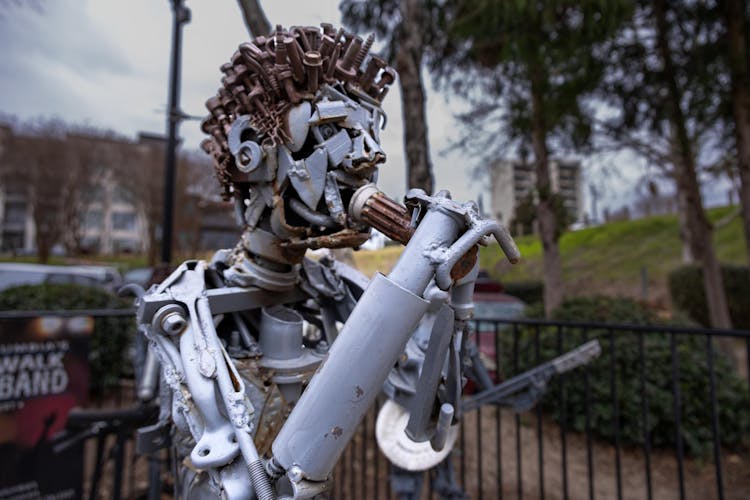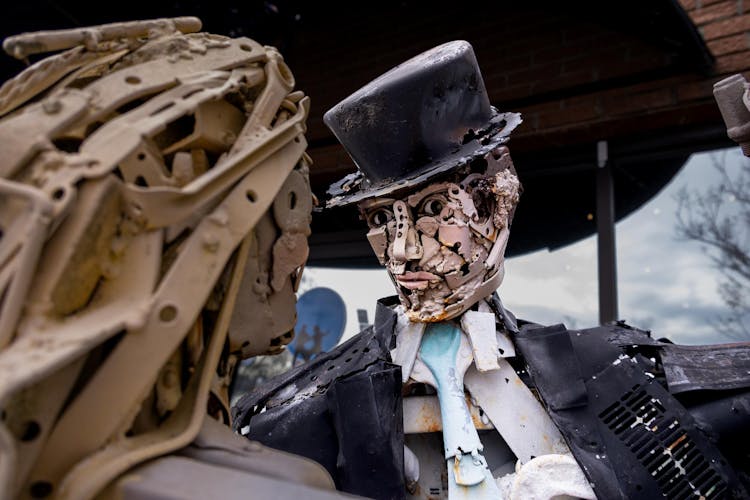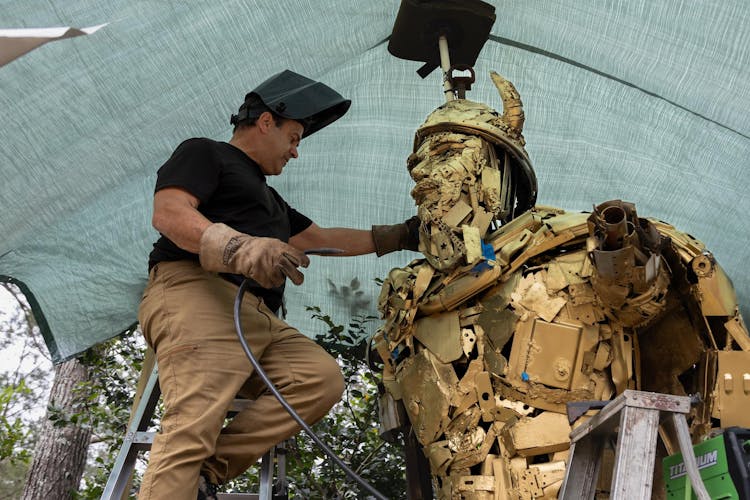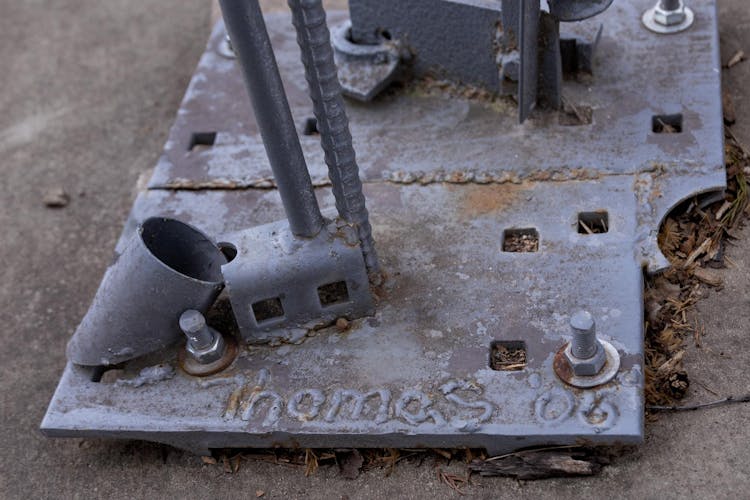All around Columbia, tall buildings, trains and USC's campus tend to steal incoming visitors' attention.
But take a closer look, and around a few corners, there are murals and sculptures decorating the sides of the roads.
Some of the city's local artists said the public art helps to make Columbia a more beautiful place to live and brings together the community and the local artists who create these pieces.
Thomas Humphries, a local artist and business owner, is the artist behind the "Recycled Life" sculpture at Riverbanks Zoo and Garden.
The metal lion that stands guard in front of the lion enclosure was made using Humphries' knowledge of welding to create "found art" — a type of artwork made using discarded and recycled items.
Humphries took up recycled art as a college student.
During a welding class, Humphries started to fall behind on a project that was due soon. He said he quickly put together a statue of a man standing on his hands, which the class loved. Humphries has enjoyed the medium since then, he said.
Unconventional art such as his lion sculpture can create excitement and diversity in the local art scene, Humphries said.
“The medium I like to use, which is the found pieces — I think it brings a little more neatness to it for people to enjoy seeing stuff used in a way they never thought about it being used,” Humphries said.
Humphries has created similar sculptures, such as a giraffe and zebra, in this style.
An affiliate of Riverbanks Zoo and Garden, upon seeing Humphries' animal sculptures, reached out to Humphries' sister-in-law to inquire about the lion. While the sculpture is currently owned by Humphries, he said he is in the process of donating it to the zoo, so it can be a permanent fixture there.
Living in a city with public art gives him the opportunity to peer into the lives of other artists in the area, he said.
"I think it's neat to have a local connection," Humphries said. "(It's) like, 'Hey, people in our town made this.'"
Cedric Umoja-Day is a multi-disciplinary Afro-futurism artist. He has created paintings using wheat paste and spray paint, some by himself and some collaboratively.
Columbia's diverse public art creates beauty of all different types, Umoja-Day said.
“I like that we see different styles, different ways of painting, different expressions,” Umoja-Day said.
Umoja-Day has painted two murals in Columbia. "Mural on Millwood," located on Millwood Avenue, consists of several murals under the names "Something for Us" and "Love, Peace, and HipHop." His other mural, "Untitled," is painted on the side of A Peace of Soul Vegan Kitchen on Main Street.
Umoja-Day said murals such as these can improve an area's atmosphere.
“It adds to the quality of life," Umoja-Day said. "It allows citizens that dwell within that city to be able to experience art."
Umoja-Day worked with two other artists, Brandon Donahue-Shipp and Karl Zurflüh, to complete "Mural on Millwood" in 2017, which was originally unfinished.
A different artist affiliated with City Year, an organization committed to helping make education more accessible, began the project. The mural depicted rows of houses and had a blank center.

The "Mural on Millwood," created by Cedric Umoja-Day, Brandon Donahue and Karl Zurfluh, sits on Millwood Avenue in Columbia, South Carolina on Feb. 27, 2024. Umoja-Day and the fellow artists created the piece in April 2017.
Umoja-Day said that when he noticed the mural had never been completed, he felt responsible as an artist to complete it.
"I used to pass this mural that was half-done on Millwood Avenue. ... I found out through some research that City Year had their hands in it, and it wasn't completed because they couldn't find enough funding to bring the artist back to complete it," Umoja-Day said. "I felt like the community there needed a completed mural."
Umoja-Day said he enjoys that people can experience public art without having to go to an art gallery or having a deep knowledge of the subject. He said his art is touching without being shocking, allowing people to connect with it.
“My art has always been in a space that everybody can engage with all the time,” Umoja-Day said.
Art should be accessible and easy to experience while also being something people can connect with without analyzing its technical value, he said.
“It’s really more so about: How does it make you feel?” Umoja-Day said. “What do you get from it as you’re experiencing this? More so than some super analytical, super hyper-intelligent type of response ... I think that all responses are intelligent when it comes to creativity.”
Umoja-Day said he considers the values of the community where his art will be placed, as he wants to respect the community's past and present while creating a vision for its future.
“All murals aren’t the same,” Umoja-Day said. “Depending where the area’s at — that’s going to be what the community calls for.”
Umoja-Day said his intentions are always the same when he goes to create a work of art. He seeks to move people and keep his art true to himself.
"I make the kind of art where you are going to get a response, but I'm not going to shock somebody with it," Umoja-Day said. "I want to make sure it is consistent with who I am."
Clay Wooten, an artist and woodworker, has been in the Columbia art scene for 15 years.
Wooten's public art in the area includes several murals and a sculpture. He has one mural on Millwood Avenue titled "Woody the Fox" and another at EdVenture Children's Museum.
Public art allows a venue for local artists to display their art while creating a brighter area for the people who live there, Wooten said.
His piece "Her Heart," located in the Vista, is a sculpture composed of quarter-inch steel rods that were hand-twisted into an anatomically correct heart. The piece represents the heart of Anastasia Chernoff, a well-known Columbia artist and gallerist who died in 2016. The work was meant to show that Chernoff's heart was "big and open," Wooten said.
Chernoff helped Wooten get his start in the area by inviting him to display his art in her gallery, which was his first Columbia art show.
Wooten said support between artists is one of the reasons why Columbia is a valuable place for public art. Chernoff uplifted Columbia artists and provided them with a space to learn and display their work, Wooten said.
“(Columbia's) got that small-town feel. So the artists are known around that area,” Wooten said. "It helps the local artists to show off their work."
Humphries said he would like to see more public art in the Columbia area. Prioritizing public art could create more space for artists in Columbia and entertaining street sides where residents can see the hard work being put in by other locals, he said.
The city could always use more art, and Columbia seems to grow more aware of this potential every day, Humphries said.
“The more the merrier. It couldn’t hurt to have a more consistent focus on trying to share the art that is made locally,” Humphries said. “I think it's just kind of neat to have more art around than less.”








